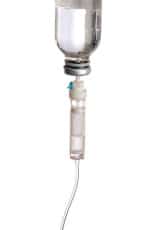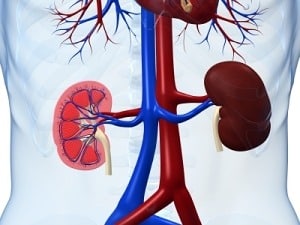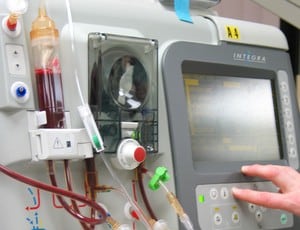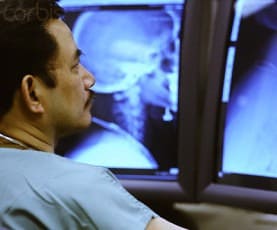Intravenous fluid bolus rates and pediatric diabetic ketoacidosis resolution

Recent data have challenged the notion that rapid intravenous fluid administration results in adverse neurologic outcomes in children with diabetic ketoacidosis (DKA)” Pruitt et al (2019). Abstract: Background: Recent data have challenged the notion that rapid intravenous fluid administration results in adverse neurologic outcomes in children with diabetic ketoacidosis (DKA). While many physicians still administer […]
Lyme disease overdiagnosis in a large healthcare system

Lyme disease serological tests were overused in a large healthcare system, and positive results were frequently misinterpreted, leading to misdiagnosis and widespread antibiotic misuse” Webber et al (2019). Abstract: Objectives: To evaluate the impact of false-positive IgM immunoblots on Lyme disease treatment and case reporting in a large healthcare system. Methods: We obtained the results […]
Preventing vascular catheter infections ISID position paper

A panel of experts was convened by the International Society for Infectious Diseases (ISID) to overview recommendations on managing and preventing vascular catheter infections, specifically for the prevention and management of central line-associated bloodstream infections” Lutwick et al (2019). Abstract: A panel of experts was convened by the International Society for Infectious Diseases (ISID) to […]
Deviation from expected PICC securement care

A PICC line is a peripheral, through a vein inserted, central venous catheter. There are different engineered stabilisation devices – some are with and some without a sutural” Port and Bruchmann (2019). Abstract: A PICC line is a peripheral, through a vein inserted, central venous catheter. There are different engineered stabilisation devices – some are […]
Evaluation of educational content of YouTube videos focused on hand hygiene

In North America alone, 74% of adults use the Internet daily, and 80% of all users search for health-related information” Ortiz-Martínez et al (2019). Abstract: The recent rise of social media usage creates a platform for the dissemination of health information to large audiences. In North America alone, 74% of adults use the Internet daily, […]
Improved central line catheter care in a pediatric cardiac intensive care unit

This article illustrates how a multidisciplinary collaboration and the use of scientific evaluation and implementation tools can facilitate a decrease in CLABSIs” Thornton et al (2019). Abstract: Central line-associated bloodstream infection (CLABSI) can result in increased length of hospital stay and increased costs for both patients and organizations. This article illustrates how a multidisciplinary collaboration […]
Pancytopenia as a consequence of sepsis and intravenous antibiotic drug toxicity

This case presents a unique case of pancytopenia involving elements of drug-induced aplastic anemia as well as DIC-related sepsis” Cho et al (2019). Abstract: This case involves a 62-year-old male with a prior history of epidural abscess and L1-L2 osteodiscitis who was admitted because of low back pain. The patient was previously treated for methicillin-susceptible […]
What US hospitals are currently doing to prevent common device-associated infections?

Despite focused initiatives to reduce device-associated infection among hospitalised patients, the practices US hospitals are currently using are unknown. We thus used a national survey to ascertain the use of several established and novel practices to prevent device-associated infections” Saint et al 92019). Abstract: BACKGROUND: Despite focused initiatives to reduce device-associated infection among hospitalised patients, […]
Clinical impact of peripherally inserted central catheters vs implanted port catheters

Our aim was to study the incidence of catheter-related deep venous thrombosis in patients with cancer receiving chemotherapy through either a PICC or a PORT” Taxbro et al 92019). Abstract: BACKGROUND: Centrally inserted totally implanted vascular access ports (PORTs) and peripherally inserted central catheters (PICCs) are widely used for the administration of chemotherapy. Our aim […]
Interventions to improve hand hygiene compliance in emergency departments

To investigate hand hygiene compliance (HHC) rate, factors affecting the HHC rate, and intervention strategies to improve HHC in EDs” Sea et al (2019). Summary: Background: The emergency department (ED) is where hand hygiene problems are significant as the procedures in the ED are often high risk and invasive. To date, there have been no […]
Catheter-related bloodstream infection by Microbacterium paraoxydans in a pediatric patient

We herein reported an 11-year-old girl with acute leukemia who was found to have catheter-related bloodstream infection in her neutropenic phase. Gram-positive bacilli repeatedly grew on the blood cultures and were later confirmed by 16S rRNA analysis as Microbacterium paraoxydans” Amano et al (2019). Abstract: Microbacterium species are coryneform gram-positive rods that are widely distributed […]
Vascular access decision making in hemodialysis

Finally, CVC use is believed to result in excess mortality in patients on hemodialysis. However, recent data suggest that CVC use is simply a surrogate marker of sicker patients who are more likely to die, rather than being a mediator of mortality” Allon (2019) Abstract: This commentary critically examines key assumptions and recommendations in the […]
Peripheral IV catheter failure in 2019

Based on these data, we asked the lead author to update readers on the status of catheter failure and what has been improved since 2015″ Helm (2019). Abstract: Still considered a “hot topic” 4 years later, JIN is pleased to reprint this classic article from May/June 2015, Issue 3. Since publication, “Accepted but Unacceptable: Peripheral […]
Peripheral IV catheter failure from 2015

“Peripheral intravenous (IV) catheter insertion, the most common invasive hospital procedure performed worldwide, is associated with a variety of complications and an unacceptably high overall failure rate of 35% to 50% in even the best of hands” Helm et al (2019).
Flow properties of cannulae for extracorporeal membrane oxygenation

The use of extracorporeal life support devices such as extracorporeal membrane oxygenation in adults requires cannulation of the patient’s vessels with comparatively large diameter cannulae to allow circulation of large volumes of blood (>5 L/min)” Broman et al (2019). Abstract: The use of extracorporeal life support devices such as extracorporeal membrane oxygenation in adults requires cannulation […]
Genetics and functionality of vascular access devices in dialysis

Thromboses and stenoses of permanent vascular access appear to be a serious hazard for patients with end-stage kidney disease on programmed haemodialysis” Kalinin et al (2019). Abstract: Thromboses and stenoses of permanent vascular access appear to be a serious hazard for patients with end-stage kidney disease on programmed haemodialysis. Relapses of these pathological conditions are […]
Economic impact of antimicrobial stewardship programmes in hospitals

Antimicrobial stewardship programmes (ASPs) include strategies that enable sustainable management of rational anti-infective treatment in the clinical setting” Huebner et al (2019). Summary: Background: Antimicrobial stewardship programmes (ASPs) include strategies that enable sustainable management of rational anti-infective treatment in the clinical setting. The successful introduction of ASPs requires close interdisciplinary collaboration among various health professionals, […]
Patient diaries during use of central venous catheters

Limited data exist regarding patients’ experiences with outpatient CVADs. This study characterized outpatient CVAD care via 14-day patient diaries” Nailon et al (2019). Abstract: Patients are increasingly receiving therapy at home via central vascular access devices (CVADs). Limited data exist regarding patients’ experiences with outpatient CVADs. This study characterized outpatient CVAD care via 14-day patient […]
Effectiveness of the K-Card process for central venous catheter maintenance bundle

The purpose of this study was to evaluate the effectiveness of the K-Card process for central venous line (CVL) maintenance bundle compliance in a pediatric intensive care unit” Frith et al (2019). Abstract: BACKGROUND: The Kamishibai Card (K-Card) process is a storytelling methodology designed to help identify barriers and remove or redesign them. PURPOSE: The […]
Leaching of DEHP into solution during various infusion situations

The work explored the DEHP migration parameters in PVC infusion in clinic, based on the previous research on the test model of DEHP migrated from PVC infusion, to assess the safety of PVC infusion” Wang et al (2019). Abstract: The work explored the DEHP migration parameters in PVC infusion in clinic, based on the previous […]
Clinical prediction model for CLABSI in children

We were able to identify risk factors and develop a clinical prediction model for CLABSI in children presenting to the emergency department” Figueroa-Phillips et al (2019). Abstract: OBJECTIVE: The majority of the children with a central line who present to the emergency department with fever or other signs of bacteremia do not have a central […]
Feasibility of extracorporeal photopheresis in pediatric patients

We retrospectively studied the feasibility, safety, and efficacy of ECP in 15 children with steroid-dependent/refractory acute or chronic GVHD, who initiated ECP treatment between April 2014 and January 2018″ Winther-Jørgensen et al (2019). Abstract: Graft-versus-host disease (GVHD) is a main cause of morbidity and mortality following hematopoietic stem cell transplantation. The cumulative incidence of acute […]
Role of the VIP score in clinically indicated peripheral IV replacement

A pre-post quality improvement initiative was implemented following complications surrounding removal of timed SPC catheters compared with those removed by clinical indication, using the Visual Infusion Phlebitis (VIP) scale” Maier (2019). Abstract: Short peripheral catheters (SPCs) are the most frequently used medical devices in hospital settings. Many hospital policies state that SPCs be replaced at […]
Closed-loop documentation system for IV infusion administration

Many studies have highlighted the patient safety risks in intravenous medication administration, and various technological solutions have been proposed to mitigate those risks, including ‘smart pumps’ and closed-loop systems” Furniss et al (2019). Abstract: Many studies have highlighted the patient safety risks in intravenous medication administration, and various technological solutions have been proposed to mitigate […]
Thrombolytic therapy with urokinase for thrombosed hemodialysis arteriovenous fistula

Arteriovenous fistula (AVF) thrombosis is a common complication in patients undergoing hemodialysis, and early intervention is required. Urokinase has been used as a thrombolytic agent for declotting the thrombosed access” Wan et al (2019). Abstract: Arteriovenous fistula (AVF) thrombosis is a common complication in patients undergoing hemodialysis, and early intervention is required. Urokinase has been […]
Teaching clinical skills in pre-registration nurse education

This article explores the value of teaching clinical skills in pre-registration nurse education. It touches on stages of competence and the knowledge necessary to enable the learner to meet the standards of proficiency expected of registered nurses” Francis and O’Brien (2019). Abstract: This article explores the value of teaching clinical skills in pre-registration nurse education. […]
Chronic venous changes induced by central lines in children

To explore the hypothesis that central venous stenosis/obstructions (CVS/O) in children are influenced by prior central venous access devices (CVADs) and are associated with future risk for thromboses” Gnannt et al (2019). Abstract: PURPOSE: To explore the hypothesis that central venous stenosis/obstructions (CVS/O) in children are influenced by prior central venous access devices (CVADs) and […]
Prevalence of idle peripherally inserted central catheters

We aimed to assess the prevalence and risks of idle peripherally inserted central catheters in adult patients” Xiong et al (2019). Abstract: BACKGROUND: Increasing studies concern about idle vascular access devices, but still scant data on idle peripherally inserted central catheters. We aimed to assess the prevalence and risks of idle peripherally inserted central catheters […]
Reducing the risk of implantable port catheter fracture

For subcutaneously implanted central venous ports, some complications due to prolonged placement have been reported. We investigated the appropriate puncture points and port placement sites to prevent catheter fracture in right internal jugular port placement” Matsunari et al (2019). Abstract: BACKGROUND: For subcutaneously implanted central venous ports, some complications due to prolonged placement have been […]
Pharmacokinetics of Cefazolin and Vancomycin in Infants

There is little evidence to describe the optimal dosing regimen for surgical site infection prophylaxis in infants undergoing cardiac surgery, and a great deal of institutional variability exists in dosing prophylactic antibiotics” Ingrande et al (2019). Abstract: BACKGROUND: Gram-positive bacteria account for nearly three-quarters of all surgical site infections. Antibiotic prophylaxis against these bacteria with […]

